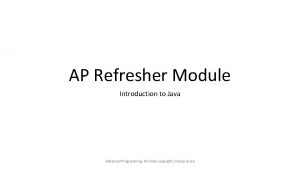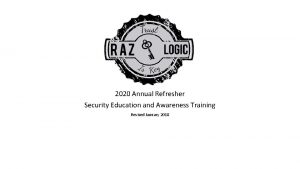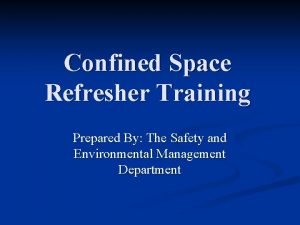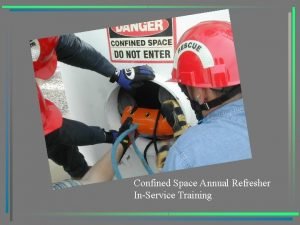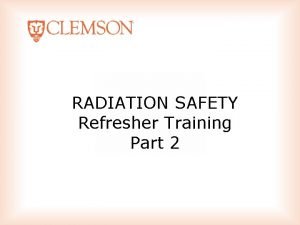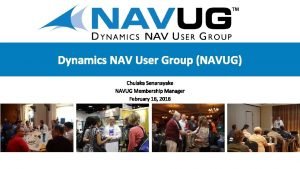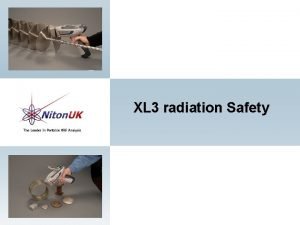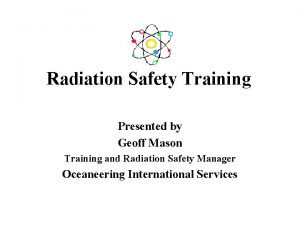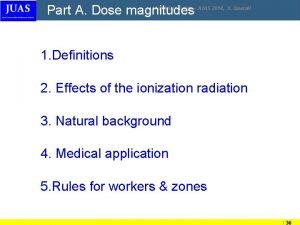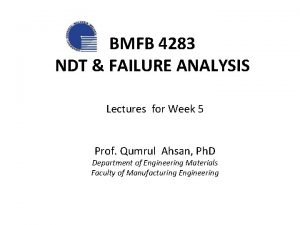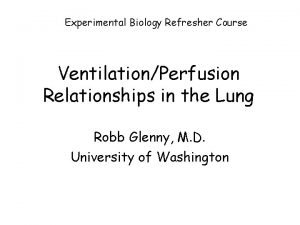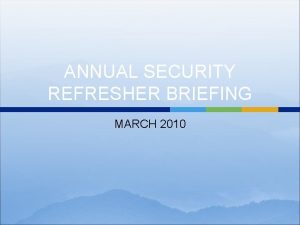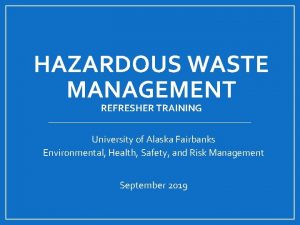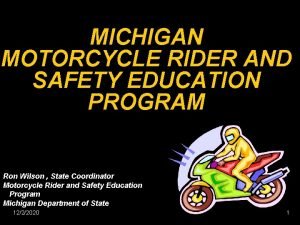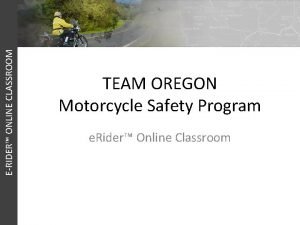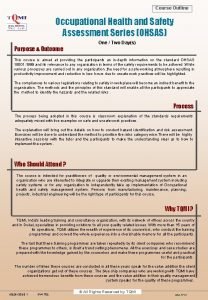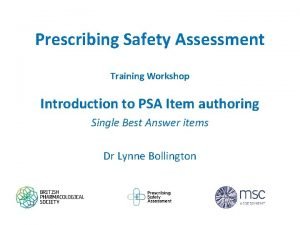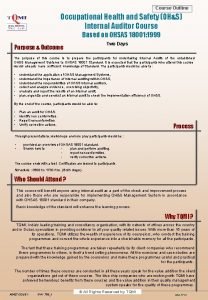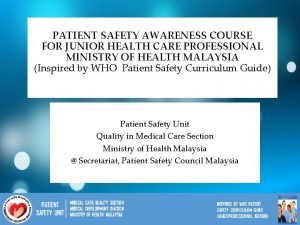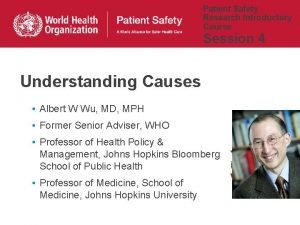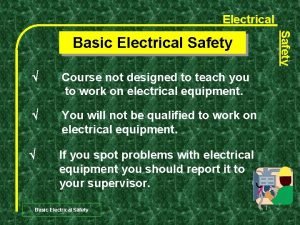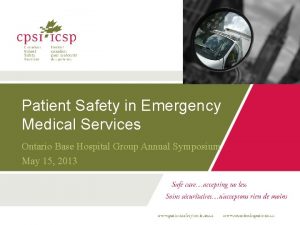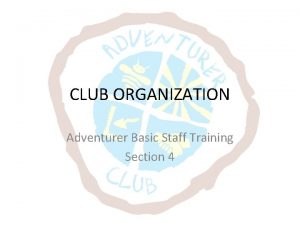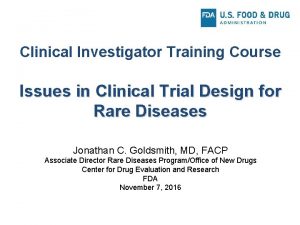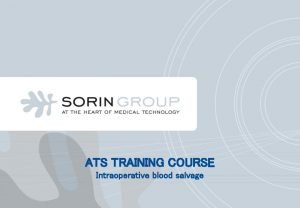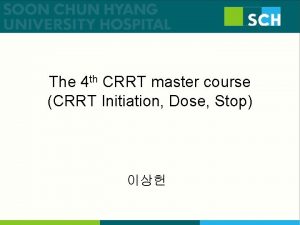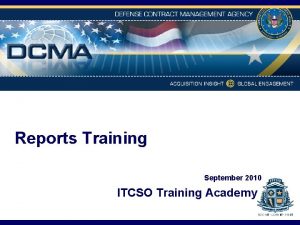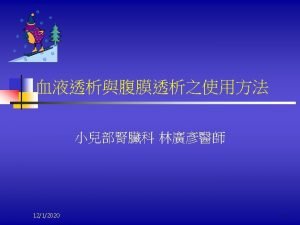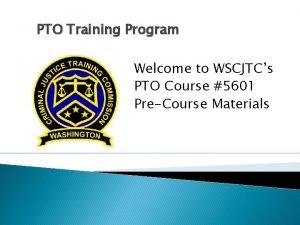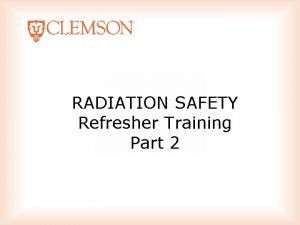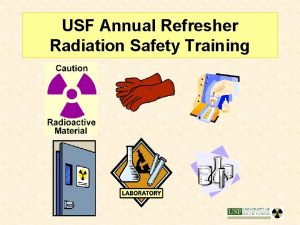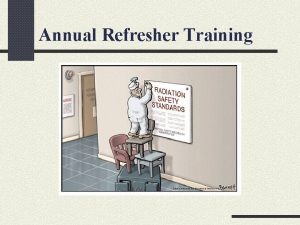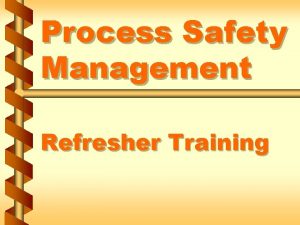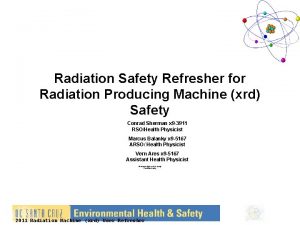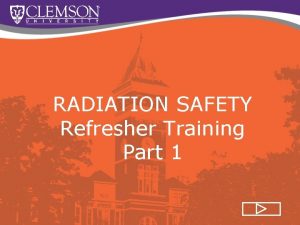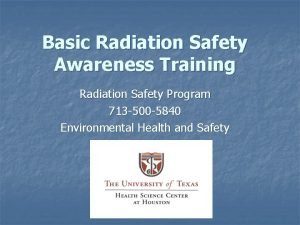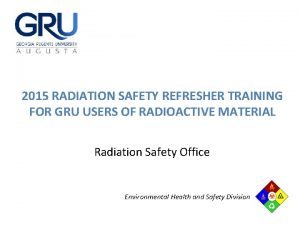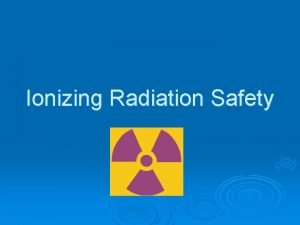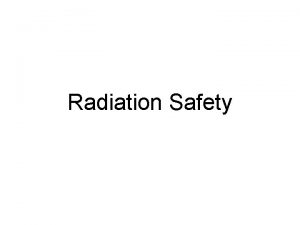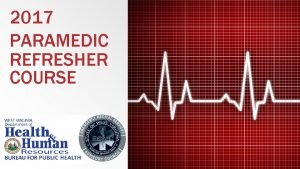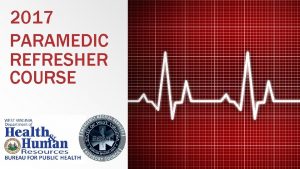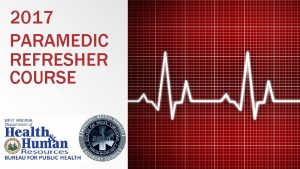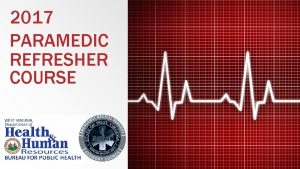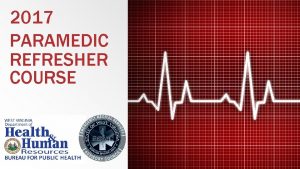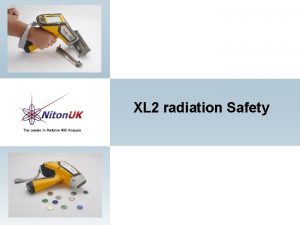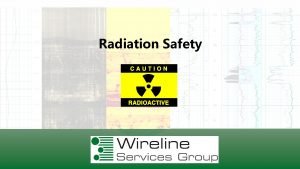RADIATION SAFETY Refresher Training Part 2 COURSE PART






















































- Slides: 54

RADIATION SAFETY Refresher Training Part 2

COURSE PART 2 OBJECTIVES • • • Radiation dose limits; dose monitoring Basic principles of radiation protection Contamination; contamination control; contamination survey Radioactive material regulations; RAM “project” Signs, postings, labels RAM ordering, use and inventory Safe laboratory practices; PPE Radioactive material security Radioactive waste disposal Emergencies

DOSE LIMITS • • Occupational dose limits set by NRC and adopted by DHEC: • Whole body: 50 m. Sv (5 rem) • Skin, extremities: 500 m. Sv (50 rem) • Lens of Eye: 150 m. Sv (15 rem) • Embryo: 5 m. Sv (0. 5 rem) • General Public: 1 m. Sv (0. 1 rem) In their rulemaking NRC uses Linear Non Threshold (LNT) model of dose effect. This model assumes increase in stochastic (cancer) risk with increase, however small, in dose. Therefore, when working with radioactive material, we must keep doses As Low As Reasonably Achievable (ALARA).

RADIATION DOSIMETRY • External Dose – From radiation sources outside the body • Internal Dose – From radiation sources inside the body • When evaluating individual’s dose, both external and internal doses must be taken into account

RADIATION DETECTION INSTRUMENTS (hover instruments for more information)

MONITORING EQUIPMENT CHECK Every day before use: 1. Check calibration expiration date. Contact radiation safety office when calibration expiration date is close or passed. Only use instrument with expired calibration in emergency and if all operational checks are OK.

MONITORING EQUIPMENT CHECK Every day before use: Meter Dial m. R/hr 1. Check calibration expiration date. 2. Check battery. Set switch to “BAT” position. Needle should be within sector “BAT TEST” (or “BAT OK”, or similar). Replace batteries if it is not. It is a good idea to always have extra batteries of proper size for your instrument. Battery Check On-Off Switch / Range Selector Battery Compartment

MONITORING EQUIPMENT CHECK Every day before use: Meter Dial m. R/hr x 100 Dial 1. Check calibration expiration date. 2. Check battery. 3. Set switch to the proper range. Usually, radiation levels in research lab should be within the lowest range. If meter pegs, switch to higher scale and press Reset button. Highest scale usually has its own dial Reset Button On-Off Switch / Range Selector

MONITORING EQUIPMENT CHECK Every day before use: 1. 2. 3. 4. Check calibration expiration date. Check battery. Set switch to the proper range. Check background radiation level in a clean area away from radiation sources. You may want to set “Fast/Slow” switch to “S” to have stable reading. Fast/Slow Response Meter Dial m. R/hr

MONITORING EQUIPMENT CHECK Every day before use: 1. 2. 3. 4. 5. Check calibration expiration date. Check battery. Set switch to the proper range. Check background radiation level. Check instrument response using dedicated check source or any other available known source of radiation (stock vial, sample, etc. ) Meter Dial m. R/hr

MONITORING EQUIPMENT CHECK Every day before use: 1. 2. 3. 4. 5. 6. Check calibration expiration date. Check battery. Set switch to the proper range. Check background radiation level. Check instrument response When performing survey, move probe slowly (~2 in/sec) over survey area. Set “Fast/Slow” switch to “F” for immediate response to Audio contamination, On-Off and Audio to ON. Fast/Slow Response Meter Dial m. R/hr

PERSONNEL DOSE MONITORING • • The use of personnel monitors is required for: • Anyone who could receive 10% of annual radiation dose limit; • Anyone who enters a high radiation area Your badge must remain at work. It is intended for measuring occupational dose only. Only wear your issued dosimeter. Store dosimeters away from radiation sources.

TLD RING DOSIMETER • Ring dosimeters are required for persons working with open beam x ray systems. • Radiation Safety Committee may require use of ring dosimeters for persons working with high activities of radioactive materials (eg. , 1 m. Ci of P 32).

DOSE REPORT

BASIC PRINCIPLES OF RADIATION PROTECTION • Time. Radiation Dose is inversely proportional to the squarematerials of the is distance from the source. Radiation Dose directly proportional to the Heavier (eg. , lead) provide better Distance INcreases x 2 >time Dose DEcreases x 4 shielding from radiation exposure Distance INcreases x 3 > Dose DEcreases x 9 • Distance. • Shielding.

RANGE OF 5 Me. V ALPHA PARTICLES External sources of alpha radiation do not require shielding. Even high energy alpha particles are easily absorbed by air, clothing and outer, dead layers of skin. Care must be taken not to allow alpha emitting materials inside human body. Material Range Air 3. 58 cm Aluminum 0. 0022 cm Water 0. 0046 cm

RANGE OF BETA PARTICLES High energy beta emitters may require shielding. To avoid production of bremsstrahlung (“breaking”) x ray radiation, use low Z materials (acrylic, Plexiglas, wood) Radionuclide (Max. Energy) Air (cm) Plastic (cm) Glass (mm) H 3 (18. 6 ke. V) 0. 47 0. 0005 0. 0002 C 14 (156. 5 ke. V) 21. 7 0. 023 0. 011 S 35 (166. 7 ke. V) 24. 8 0. 0267 0. 012 P 32 (1710 ke. V) 581 0. 625 0. 288

PHOTON ATTENUATION • Half Value Layer – Thickness of an absorber that reduces the intensity of a radiation beam by 50% Energy Water Lead 100 ke. V 4 cm 0. 1 cm 400 ke. V 6. 5 cm 0. 3 cm 1 Me. V 10 cm 1 cm

BASIC PRINCIPLES OF RADIATION PROTECTION • Time. Contamination is a source of both external and internal contamination • Distance. • Shielding. • Contamination Control

SOURCES OF CONTAMINATION • Sloppy work practices, such as cross contamination of tools, equipment, or workers. • Not wearing gloves, or removing them prematurely. • Poor housekeeping in contaminated areas. • Opening radioactive materials/systems without proper controls. • Leaking containers or tears in radiological containers such as barrels, plastic bags, boxes, or protective gear. • Spills, glass breakage, and animal fluids. • Airborne contamination depositing on surfaces. • Not adhering to standard laboratory procedures. • Emergencies including: • Fire. • Earthquake, etc.

CONTAMINATION PREVENTION • Plastic backed absorbent paper should cover all surfaces where open radioactive sources are handled. Lab coats, gloves and safety glasses, goggles or face shield must be worn when working with radioactive material. • When wearing gloves, never touch anything that you will handle without gloves: pens, notebooks, telephones, switches, door handles, computer keyboard, etc. • Secondary containment must be used for transfer and storage of all radioactive materials.

CONTAMINATION SURVEY • Contamination surveys should be performed after handling RAM, before breaks, lunch, at the end of work day. • Recordable lab contamination surveys must be performed every week RAM is used in the lab. • Use survey equipment suitable for detection of RAM used at location being surveyed. • To survey for removable contamination, approximately a 100 cm 2 area should be “swiped” in an “S” shaped pattern. • Record results of the survey. • Any area with an alpha or beta count rate significantly over background should be immediately cleaned.

CONTAMINATION SURVEY RECORD • Contamination survey report must contain: • Drawing of the surveyed area; • Locations of measurements and/or swipes taken; • Model and serial number of instrument(s) used for survey; • Date and time of survey; • Results of measurements; • Identity of the person performed survey

CONTAMINATION LIMITS • Contamination can be: • Fixed – cannot be readily removed • Removable – can be readily removed with basic wiping or casual contact • Airborne – contamination suspended in air, presents the possibility of inhalation • Contamination Limits: Type of Contamination Removable Fixed Beta/Gamma < 200 dpm/100 cm 2 < 100 cpm above bkg, or < 0. 05 m. R/h Alpha < 20 dpm/100 cm 2 N/A • Any detectable contamination should be cleaned as well as reasonably possible.

SPILLS OF RADIOACTIVE MATERIAL • All spills of RAM require immediate response. Initial response to a spill rests with the lab personnel. Untrained personnel is not allowed to examine or clean RAM spill. • Minor spills may be decontaminated by lab personnel. • If contamination widespread, includes unrestricted areas, unauthorized personnel, or involves high μCi or m. Ci amounts of RAM, notify RSO. • Notify all lab personnel. Have all personnel not involved with the spill to vacate the area, but remain in one place to minimize possibility of contamination spread. • Contain the spill from further spread. If the material is a liquid, place an absorbent material over the spill to prevent its spread. If the material spilled is a powdered solid, attempt to contain its spread by covering the area with a protective barrier (ex. , wet cloth or absorbent paper). If appropriate, close doors and windows, turn off room ven tilation fans.

SPILLS OF RADIOACTIVE MATERIAL (continued) • Monitor any personnel that were in the area at the time of the spill. Give special attention to the nose and mouth areas. Report any facial contamination to the RSO immediately. • Remove contaminated clothing at once; flush contaminated skin areas thoroughly. • Decontaminate the area: Plan ahead. Provide adequate protection and supplies for personnel involved in the cleanup. Besides required PPE, wear double gloves and shoe covers. Begin at the periphery and work toward the center of the contamination. Cover cleaned areas with plastic or paper to prevent its recontamination. Place all contaminated items in the proper waste containers. • Monitor the area: Survey area after each decontamination effort. If contamination persists after several decontamination efforts, notify RSO.

INTERNAL EXPOSURE PATHWAYS • Inhalation – Gases, aerosols, dusts, mists, fumes, smoke (including cigarettes) • Ingestion – Food, water, hand contamination • Absorption thru Skin – Thru intact skin, cuts, abrasions, etc. • Punctures – Needle sticks

ANNUAL LIMITS ON INTAKE (ALI), TEDE • ALI The amount of radioactive material taken into the body of an adult worker that would result in a radiation dose of 50 m. Sv (5 rem) to the whole body or 500 m. Sv (50 rem) to any individual tissue or organ per year • ALI allows to account for effects of the internal exposure in conjunction with the external dose • Total Effective Dose Equivalent (TEDE) takes into account both external and internal exposures. TEDE is the sum of effective dose equivalent from external exposure and committed effective dose equivalent from internal exposure

ALI VALUES ALI’s for all radioisotopes have been calculated and listed by the NRC. There are some examples below: Radionuclide Ingestion Tc 99 m H 3 (Water) S 35 I 123 C 14 P 32 I 125 I 131 80, 000 10, 000 3, 000 2, 000 600 4 3 Inhalation μCi μCi 200, 000 80, 000 20, 000 6, 000 2, 000 400 60 60 μCi μCi

TEDE CALCULATION EXAMPLE • • Nuclear medicine technician works with I 131 Personal dosimeter shows annual dose of 500 mrem Thyroid counting using Na. I(Tl) indicated I 131 uptake of 1. 5 µCi What is technician’s TEDE and how it compares to the occupational dose limit? I 131 ALI is 3 µCi, therefore, committed effective dose equivalent from the uptake of 1. 5 µCi equals (1. 5/3)*5 = 2. 5 rem Measured external dose equivalent is 500 mrem Adding external and internal doses, we have for TEDE: 2. 5 rem + 500 mrem = 3 rem, which is (3/5)*100 = 60% of the occupational dose limit

SKIN DECONTAMINATION Mechanical Remove with Sticky Tape Washing Soap or Detergent and Cool Water Surgical Scrub Brushes with Povidone Iodine Complexing Agents (1% Citric Acid) Chelating Agents (1% Versene) Biological Sweat it out Washing affected areas with soap and cool to lukewarm water is the first, and usually, the only required action for skin decontamination at a research lab of the Clemson University

RADIOACTIVE MATERIAL AUTHORIZATION • • The Nuclear Regulatory Commission (NRC) is the Federal agency authorized by the Congress to regulate radioactive material use States that assume the function of the NRC are called Agreement States South Carolina became an Agreement State in 1969 South Carolina’s Department of Health and Environmental Control (DHEC): • licenses radioactive material use; • regulates X ray registration and use; • performs inspections of licensed facilities; • regulates use of lasers.

RADIOACTIVE MATERIAL AUTHORIZATION • • Clemson University has a Broad Scope Radioactive Material License Allows use of radioactive isotopes with atomic numbers 1 98 in any chemical or physical form All activities involving radioactive material (“projects”) within the Clemson University must be approved by the Radiation Safety Committee (RSC) RAM Project includes: • Responsible Investigator (RI); • list of authorized isotopes and possession limits; • list of personnel; • facilities where RAM use is authorized; • approved protocol( s).

PERIODIC INSPECTIONS • • • Clemson University’s Radioactive Material License requires semi annual inspections of RAM projects; Radiation safety personnel contacts project’s RI to set mutually acceptable date and time for inspection; RI does not have to be physically present during inspection, but (s)he has to assign AU to assist inspector. This AU has to be knowledgeable about project’s activities and capable to answer inspector’s questions.

WHO MAY WORK WITH RADIOACTIVE MATERIAL? • • Only individuals listed on a Project may use RAM; Must receive instructions from the RI; To become Authorized User (AU), must complete Initial Radiation Safety training; • may start working with RAM before attending Initial Training, but only under direct supervision of RI or AU (status called Radiation Worker (RW)); Must complete annual refresher training (online or classroom).

WHO MAY WORK WITH RADIOACTIVE MATERIAL? • • • Fill form R 003 Request To Add An Individual To A Radionuclide Project and submit to Radiation Safety. You may be listed on several Projects. Or, you may start your own project.

SIGNS, POSTINGS, LABELS • • All entrances to the labs where RAM is used or stored must be posted with the “Caution, Radioactive Material” sign. Assume all materials within radioactive materials area are potentially contaminated. • • All areas where dose rate is above 5 mrem/hour must be posted with the “Caution, Radiation Area” sign. Do not enter radiation area unless absolutely necessary and you are authorized to do so.

SIGNS, POSTINGS, LABELS • All equipment, containers, glassware, tools, etc. that may come into contact with RAM must be labelled with “Caution, Radioactive Material” Sign.

ORDERING RADIOACTIVE MATERIAL • You can only order radionuclides that the project is authorized for and within your possession limits • Use a licensed supplier (Amersham, MP Biomedicals, Perkin Elmer, etc. ) • All radioactive material shipments must be addressed to: 504 Lake Dr. Clemson, SC 29631 342 Computer Ct. Anderson, SC 29625 For: RN <your project>, <RI name> • Research Park (Rich, CETL) was recently added as approved destination for RAM packages

RADIOACTIVE MATERIAL USE RECORD Upon RAM package receipt, radiation safety personnel: • checks radiation and contamination levels, package labelling and documentation; • assigns shipment number; • adds RAM to the project’s inventory and checks against possession limits; • produces RAM Use/ Inventory Record; • notifies project personnel and delivers shipment.

OPENING PACKAGE Follow these steps when opening RAM package in your lab: • Check paperwork to make sure that you are an intended recipient and you received what you ordered; • Open package, check integrity of the internal packaging. Notify Radiation Safety Office and manufacturer if internal package is broken and/or leaks; • Remove container with RAM from the packaging and mark it with the shipment number listed on the RAM Use form; • Survey inside of the packaging for residual contamination. Use appropriate survey equipment. • Remove or deface Radioactive Material labels from the packaging and dispose of it.

DEFACING LABELS Wrong Right

RADIOACTIVE MATERIAL TRANSFER • Inside Clemson: make sure transferee is approved to possess RAM being transferred; • Outside Clemson: obtain a copy of the other institution’s RAM license; • Complete Radioactive Material Transfer Report; • For shipping outside Clemson RAM must be packaged according to DOT/IATA rules; • Package and paperwork must be inspected by the RSO.

GENERAL LAB RULES • • Working with radioactive material in a research laboratory may involve exposure to many other hazards: chemical, biological, mechanical, electrical, etc. Following best lab practices described in the Laboratory Safety Manual is critical in avoiding these hazards. www. clemson. edu/research/safety/manuals/lab. Safety/index. html • Besides general lab safety, radiation safety requires additional considerations.

SAFE LAB PRACTICES • All work areas should be kept uncluttered to prevent accidents and minimize cross contamination. • There must be no eating, drinking, smoking, or storage of food in areas in which radioactive materials are used. • No mouth pipetting is allowed in a radioisotope work area. • Containers used in mixing, shaking, or centrifuging operations should be intact and sealed to prevent spillage. • Heating, drying, distilling, and other operations which could result in volatilization of the material should be performed in a fume hood or glove box. • Whenever possible, rehearse operations with non radioactive materials to ensure that the technique will be reasonably free of incidents. • Maintain accurate records of radioactive material use.

PERSONAL PROTECTIVE EQUIPMENT • When working with radioactive material minimum required PPE is lab coat, gloves and safety glasses or goggles. • No shorts, no open toe shoes, no short sleeves are allowed for any lab work. • Depending on the scope of activities and hazards involved, additional PPE requirements may be imposed on a project personnel by the Radiation Safety Committee.

RADIOACTIVE MATERIAL SECURITY • • Radioactive material must be secured against unauthorized use or removal • Entrances to unoccupied labs must be closed and locked, or • All radioactive material, including waste, must be kept in locked cabinets NRC commentary on 10 CFR PART 20: “The Commission believes that locking radiotracer laboratories when not being used is a small nuisance compared to the consequences of unauthorized access to or theft of radioactive materials, which could result in contamination of unrestricted areas or exposure of individuals, as well as having to report a loss of licensed material to the NRC. ”

ESCORTING VISITORS IN THE LABORATORY • Inform guests that they are entering a radioactive materials area. • Point out locations of any hazards or high radiation areas. • Do not allow guests to handle any materials from a radioactive materials area. • Demonstrate how to perform a personal scan prior to exiting the lab (or, survey them yourself). • If guests will be working with you in the lab, consult with RSO if personal dosimetry is required. But remember, only individuals listed on the RAM Project may work with radioactive material.

RADIOACTIVE WASTE DISPOSAL • Dry solid waste must be separated into Short (less than 65 day) and Long half life. Waste bags and containers are color coded: green for short, yellow for long half life.

RADIOACTIVE WASTE DISPOSAL • Deface all “Radioactive Material” labels before placing items into radioactive dry waste container. • Prohibited for disposal into radioactive dry waste: • sharp objects; • sealed sources; • biohazardous waste or bags; • lead containers • liquids • Sharp objects must be collected in a special sharps waste container labelled with “Radioactive Material” sign • Radioactive biohazard waste must be treated in the same manner as regular biohazard waste (i. e. , autoclaving, bleach) before being placed into radioactive waste containers.

RADIOACTIVE WASTE DISPOSAL • For mixed (hazardous + radioactive) liquid waste follow hazardous waste compatibility guidelines. • If possible, use biodegradable LSC cocktail. • Do not wait for waste containers to overflow. Request waste pick up when containers are about 2/3 full. • Do not let housekeeping personnel to empty radioactive waste containers. • Keep reasonably accurate waste disposal record.

LIQUID RADIOACTIVE WASTE DISPOSAL • Some projects may be allowed to dispose liquid radioactive waste down the sewer. These disposals must be approved by the Radiation Safety Committee. • Only materials that are soluble or miscible in water or biological materials that are readily dispersible may be disposed via sink. • No hazardous chemicals! Mixed liquid waste containing short half-life RAM will be held by Radiation Safety Office for minimum of 10 half-lives, and then disposed as hazardous non-radioactive waste. Long half-life mixed waste has to be disposed through approved waste broker, and it is expensive! • It is very important to keep reasonably accurate record of all sewage disposals.

EMERGENCIES • Personal safety and health take precedence over radiological concerns. • Notify Radiation Safety in the event of radiological emergency: • accidental uptake; • lost/stolen RAM; • fire (call 911 first), flood, etc. • Konstantin Povod, RSO • 656 3516, • kpovod@clemson. edu • Ayman Seliman, ARSO • ayman@clemson. edu

SUMMARY • • • Follow general lab safety rules. Apply Time Distance Shielding to keep doses ALARA. Control contamination. Perform surveys at meaningful times. Maintain records of RAM use and disposal. If you cannot resolve a safety issue bring it to the attention of your peer/advisor/RSO. You are the primary responsibility for your safety and safety of your peers!
 Java programming refresher
Java programming refresher Ipv refresher course
Ipv refresher course Saeta refresher course 2021
Saeta refresher course 2021 Gdpr refresher training
Gdpr refresher training Security annual refresher training
Security annual refresher training Confined space refresher training
Confined space refresher training Confined space refresher training
Confined space refresher training Refresher training example
Refresher training example Refresher training example
Refresher training example Safety care certification
Safety care certification Radiation safety
Radiation safety Geoff mason
Geoff mason Background radiation
Background radiation Radiation safety
Radiation safety Sql refresher
Sql refresher Chemistry molarity
Chemistry molarity Alveolar gas equation
Alveolar gas equation Refresher briefing
Refresher briefing Stream exercises java
Stream exercises java Red helmet training
Red helmet training Ifr refresher
Ifr refresher Hazmat training alaska
Hazmat training alaska Biology refresher
Biology refresher Solar radiation has a part in the water cycle by
Solar radiation has a part in the water cycle by English bond t junction
English bond t junction Course title and course number
Course title and course number Course interne moyenne externe
Course interne moyenne externe Tractor safety course oregon
Tractor safety course oregon Safety leadership training for supervisors
Safety leadership training for supervisors Motorcycle safety course michigan
Motorcycle safety course michigan Erider oregon
Erider oregon Occupational health and safety assessment series
Occupational health and safety assessment series Army traffic safety introductory course
Army traffic safety introductory course Prescribing safety assessment
Prescribing safety assessment Occupational health and safety course outline
Occupational health and safety course outline 13 malaysian safety goals
13 malaysian safety goals Osa online safety
Osa online safety Nevada boater certification
Nevada boater certification Army traffic safety introductory course
Army traffic safety introductory course Basic electrical safety course
Basic electrical safety course Erider team oregon
Erider team oregon Canadian patient safety officer course
Canadian patient safety officer course Cognitive stimulation therapy training course
Cognitive stimulation therapy training course Weights and measures training course
Weights and measures training course What is tasp army
What is tasp army Adventurer uniform
Adventurer uniform Cabin crew training course in malaysia
Cabin crew training course in malaysia Defensive driving presentation
Defensive driving presentation Cognitive stimulation therapy training course
Cognitive stimulation therapy training course Clinical investigator training program
Clinical investigator training program Autotransfusion training course
Autotransfusion training course Crrt training course
Crrt training course Jet reports training course
Jet reports training course Pd
Pd Pto course
Pto course
